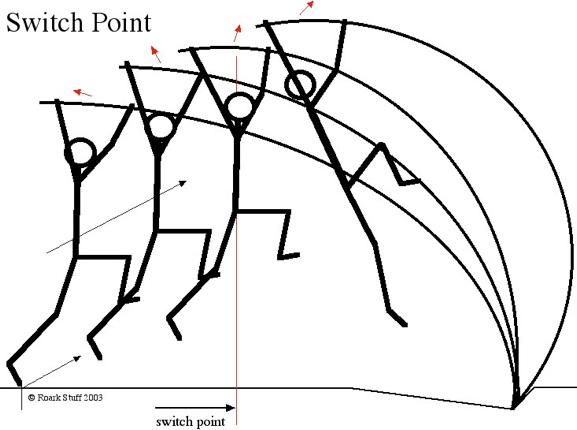The “Switch Point”
By Alan Roark, vault coach, Amherst Steele HS, Amherst, Ohio
(The following article assumes a fast run and proper take-off point.)
Here’s a concept that can help your vaulters get on bigger, longer poles and vault safely, landing well into the pit with the standards at 30 inches (76cm).
I call it “understanding the “switch point” of the pole you’re on”. Every pole has a “roll over point” where the lifting and resistance forces of the pole move from back down the runway, to straight up, to up and forward. If the vaulter tries to swing up before the pole gets to where the up and forward forces occur, they will stall out over the box, or get rejected back down the runway. I’m constantly telling my vaulters, “jump, travel, swing”. You must “JUMP” (take off aggressively forward and up), “TRAVEL” (follow-through after the take-off), then “SWING” (move the trail-leg through in a long, sweeping arc to create lift). The “TRAVEL” or follow-through is what gets them to the “switch point” so they can go up and forward, landing safely in the coach’s box on the pit. (That’s a GOOD thing)
Some coaches say you swing immediately off the ground and some say you have to drive the pole forward. What I say is, “if you’re on a soft pole, you have to swing fast or you’ll blow through the vault, and if you’re on a stiff pole, you have to drive in so you don’t stall out.” Both explanations are saying, “you have to get to the switch point before you swing up.” On the soft pole you won’t recognize the “travel” or “follow-through” because it happens so fast, but it WAS there. If you made it into the pit, you DID get to the switch point. Another way to think about it would be, “take-off at 12, swing at 9.”
Where this is most important to understand it when a vaulter moves to a longer pole. They should hold at most one hand grip higher than on the shorter pole and then do many, many vaults to get used to the higher sail piece and the longer “travel” or “follow-through” it takes to get to the switch point for the longer pole. After they’re really comfortable with the new distance, they can move up the pole one grip at a time as they learn to get to the switch point and move their take off point farther out. (This will be another article) One of the most radical differences occurs when moving from a 15’ pole to a 16’ pole. There’s a BIG difference in getting to the “switch point” on a 16’ pole. Don’t let them move their grip up or swing up until the can feel where it’s safe to do so. Also, don’t let them move the standards closer than 24”. (Go to a softer pole so they land well into the pit.)
I’ve been to several college meets and see vaulters on 16’ poles stall out. I just say to myself, “they did a 15’ follow-through on a 16’ pole”.
Below is a drawing showing the “switch point” concept. The small arrows above the hands show the direction of the force the pole is putting on the hands of the vaulter. (If you use a 10’ piece of 1” PVC pipe and hold it like a pole, put it in the box, put your top hand up high, and walk slowly toward the pit while the pipe bends, you can feel the forces yourself. When you start walking, your top hand is pushed backward. As you walk farther in, the force becomes all lift. This change in force direction is what happens with a real pole during the vault.)
